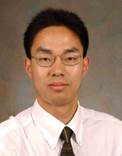学术报告1: Light-Assisted3D Bioprinting of Micro- and Nano-scale Functional Biomaterials
报告人:Shaochen Chen教授(美国加州大学圣地亚哥分校纳米工程系)
学术报告2: Three-DimensionalBioprinting and Evaluation of Process-Induced Cell Injury
报告人:Yong Huang教授(美国佛罗里达大学机械与航空工程系)
报告时间:2015年7月10日 (周五) 上午9:00-12:00
报告地点:浙江大学玉泉校区机电所老楼4楼会议室
联系人:梅德庆,13588370580,medqmei@zju.edu.cn
欢迎广大师生参加!
学术报告1:Light-Assisted 3D Bioprintingof Micro- and Nano-scale Functional Biomaterials
ShaochenChen, Ph.D.
Professorof NanoEngineering and Bioengineering Departments
Co-Director,Biomaterials & Tissue Engineering Center, Institute of Engineering in Medicine,University of California, San Diego
Abstract
The goal of our laboratory is to develop micro- and nano-scale bioprintingtechniques for the direct-write of 3D designer scaffolds used for tissueengineering and regenerative medicine. In this webinar, I will present mylaboratory’s recent research efforts in femtosecond laser nano-printing andprojection 3D bioprinting to create 3D scaffolds using a variety ofbiomaterials. These 3D biomaterials are functionalized with precise control of micro-architecture,mechanical (e.g. stiffness and Poisson’s ratio), chemical, and biologicalproperties. Design, fabrication, and experimental results will be discussed. Suchfunctional biomaterials allow us to investigate cell-microenvironmentinteractions at nano- and micro-scales in response to integrated physical andchemical stimuli. From these fundamental studies we can create both in vitro and in vivo tissue models for precision tissue engineering andregenerative medicine.
About the Speaker

Dr.Shaochen Chen is a Professor in the NanoEngineering Department andBioengineering Department at the University of California, San Diego (UCSD). Hedirects the Biomaterials and Tissue Engineering Center at UCSD. Before joiningUCSD, Dr. Chen had been a Professor and a Pearlie D. Henderson CentennialEndowed Faculty Fellow in Engineering in the Mechanical Engineering Departmentat the University of Texas at Austin from 2001 to 2010. Between 2008 and 2010,he served as the Program Director for the Nanomanufacturing Program in the USNational Science Foundation (NSF). Dr. Chen’s primary research interestsinclude: biomaterials and bioprinting, nanomanufacturing,regenerative medicine, tissue engineering, laser and nanophotonics. Dr. Chenhas published 101 papers in top journals such as Nature Communications, Nature, Nature Materials, Nano Letters, Biomaterials, Advanced Materials, and 12 book/book chapters.
Amonghis numerous awards, Dr. Chen received the CAREER award from NSFand Young Investigator award from theOffice of Naval Research (ONR). As an active member in his professionalcommunity, Dr. Chen is a Fellow of the American Association for the Advancementof Science (AAAS), Fellow of the American Institute for Medical and BiologicalEngineering (AIMBE), Fellow of the American Society of Mechanical Engineers(ASME), Fellow of the International Society for Optics and Photonics (SPIE),and Fellow of the International Society for NanoManufacturing (ISNM).
学术报告2:Three-DimensionalBioprinting and Evaluation of Process-Induced Cell Injury
YongHuang, Department of Mechanical and Aerospace Engineering, University ofFlorida, Gainesville, FL 32611
Abstract
Maskless jetbased(including laser- and inkjetbased) threedimensional (3D) cell printing is arevolutionary advance for printing arbitrary cell patterns as well as creatingheterogeneous living constructs. Most importantly, cell printing provides apromising solution to the problem of organ donor shortages by printing 3Dtissue/organ constructs for implantation, resulting in what is known as organprinting. Unfortunately, process-induced thermomechanical injury to cells aswell as other biomaterials during printing still poses a significant challengeto ensuring a satisfactory post-transfer cell viability. As previous studiesshow, process-induced thermomechanical loading can dramatically increase thecell mortality rate if printing conditions are not properly selected.
Using a representativelaser cell printing technology (modified laser-induced forward transfer) as ajet-based model system, we have been addressing the aforementionedprinting-induced cell injury challenge by studying 1) the process-induced cellthermomechanical loading profiles during the cell droplet formation and landingprocesses, two key processes during cell printing; and 2) the post-transfercell viability based on the process-induced thermomechanical loading profiles.In this talk, the perspective of ongoing cell printing research is firstintroduced. Then the modeling of the laser-induced cell droplet formation andsuccessive landing processes and resultant cell mechanical loading isdiscussed. Finally, the relationship between the post-transfer cellinjury/viability and the mechanical loading information is captured through anapoptosis signaling pathway-based modeling approach.
About the Speaker

Dr. YongHuang is a professor of Mechanical Engineering, Biomedical Engineering, andMaterials Science and Engineering at the University of Florida, Gainesville,Florida. His research interests are twofold: processing of biological andengineering materials for healthcare/energy applications and understanding ofprocessinduced damage or defect structures. His current research topicsinclude threedimensional (3D) printing of biological and engineeringstructures, precision engineering of medical implants and performanceevaluation of machined implants, and fabrication of polymeric microspheres / microcapsules/ hollow fiber membranes. He served as the Technical Program Chair for the 2010American Society of Mechanical Engineers International Manufacturing Scienceand Engineering Conference (MSEC 2010) and the 2012 International Symposium onFlexible Automation (ISFA 2012). He received various awards for hismanufacturing research contributions including the ASME Blackall Machine Tooland Gage Award (2005), the SME Outstanding Young Manufacturing Engineer Award(2006), the NSF CAREER Award (2008), and the ASME International Symposium onFlexible Automation Young Investigator Award (2008). He received his Ph.D. inMechanical Engineering from the Georgia Institute of Technology in 2002 and isa Fellow of ASME.
